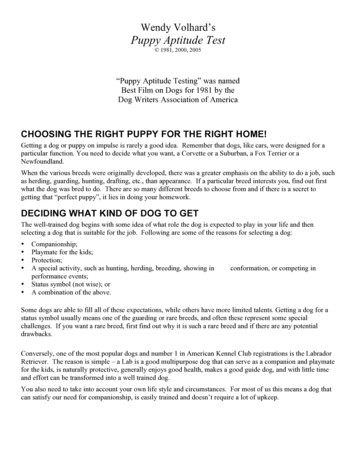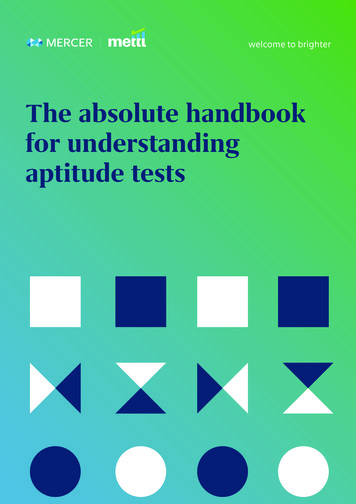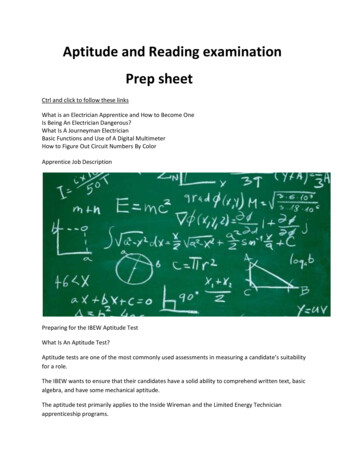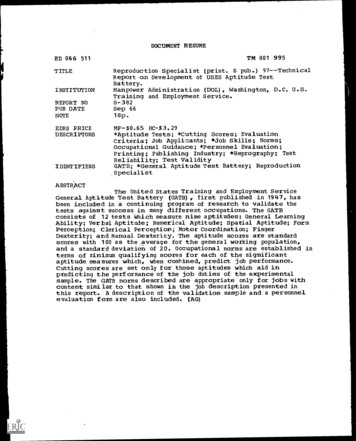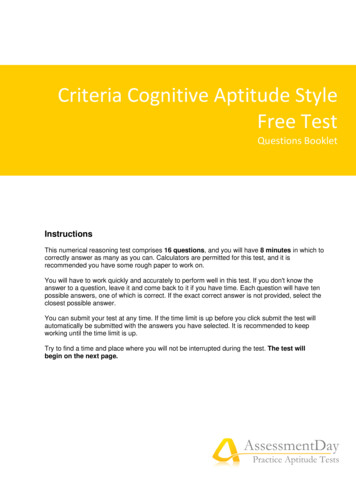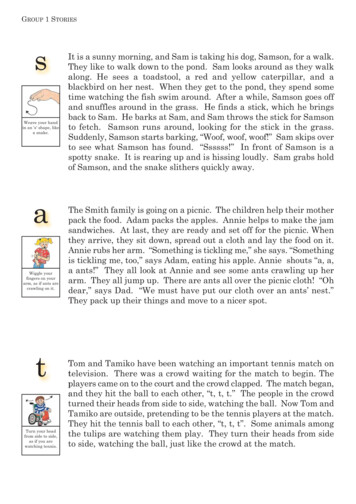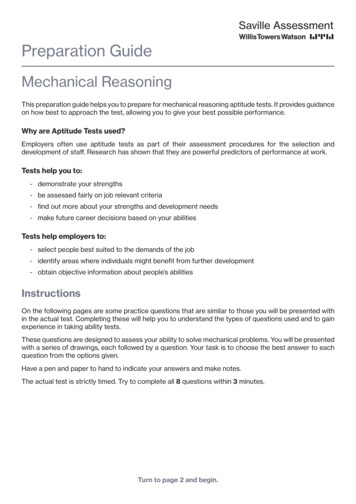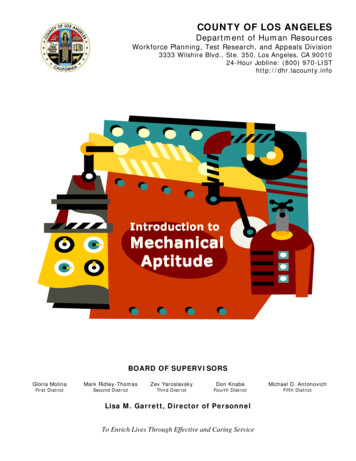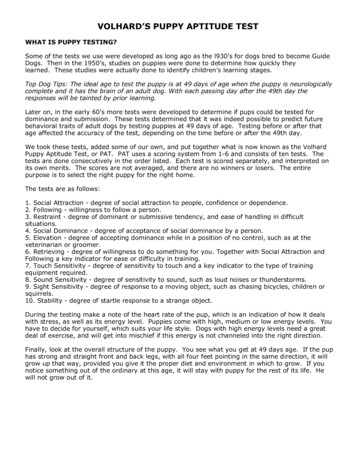
Transcription
VOLHARD’S PUPPY APTITUDE TESTWHAT IS PUPPY TESTING?Some of the tests we use were developed as long ago as the l930’s for dogs bred to become GuideDogs. Then in the 1950’s, studies on puppies were done to determine how quickly theylearned. These studies were actually done to identify children’s learning stages.Top Dog Tips: The ideal age to test the puppy is at 49 days of age when the puppy is neurologicallycomplete and it has the brain of an adult dog. With each passing day after the 49th day theresponses will be tainted by prior learning.Later on, in the early 60’s more tests were developed to determine if pups could be tested fordominance and submission. These tests determined that it was indeed possible to predict futurebehavioral traits of adult dogs by testing puppies at 49 days of age. Testing before or after thatage affected the accuracy of the test, depending on the time before or after the 49th day.We took these tests, added some of our own, and put together what is now known as the VolhardPuppy Aptitude Test, or PAT. PAT uses a scoring system from 1-6 and consists of ten tests. Thetests are done consecutively in the order listed. Each test is scored separately, and interpreted onits own merits. The scores are not averaged, and there are no winners or losers. The entirepurpose is to select the right puppy for the right home.The tests are as follows:1. Social Attraction - degree of social attraction to people, confidence or dependence.2. Following - willingness to follow a person.3. Restraint - degree of dominant or submissive tendency, and ease of handling in difficultsituations.4. Social Dominance - degree of acceptance of social dominance by a person.5. Elevation - degree of accepting dominance while in a position of no control, such as at theveterinarian or groomer.6. Retrieving - degree of willingness to do something for you. Together with Social Attraction andFollowing a key indicator for ease or difficulty in training.7. Touch Sensitivity - degree of sensitivity to touch and a key indicator to the type of trainingequipment required.8. Sound Sensitivity - degree of sensitivity to sound, such as loud noises or thunderstorms.9. Sight Sensitivity - degree of response to a moving object, such as chasing bicycles, children orsquirrels.10. Stability - degree of startle response to a strange object.During the testing make a note of the heart rate of the pup, which is an indication of how it dealswith stress, as well as its energy level. Puppies come with high, medium or low energy levels. Youhave to decide for yourself, which suits your life style. Dogs with high energy levels need a greatdeal of exercise, and will get into mischief if this energy is not channeled into the right direction.Finally, look at the overall structure of the puppy. You see what you get at 49 days age. If the puphas strong and straight front and back legs, with all four feet pointing in the same direction, it willgrow up that way, provided you give it the proper diet and environment in which to grow. If younotice something out of the ordinary at this age, it will stay with puppy for the rest of its life. Hewill not grow out of it.
HOW TO TESTHere are the ground rules for performing the test: The testing is done in a location unfamiliar to the puppies. This does not mean they have totaken away from home. A 10-foot square area is perfectly adequate, such as a room in the housewhere the puppies have not been. The puppies are tested one at a time. There are no other dogs or people, except the scorer and the tester, in the testing area The puppies do not know the tester. The scorer is a disinterested third party and not the person interested in selling you a puppy. The scorer is unobtrusive and positions him or herself so he or she can observe the puppies’responses without having to move. The puppies are tested before they are fed. The puppies are tested when they are at their liveliest. Do not try to test a puppy that is not feeling well. Puppies should not be tested the day of or the day after being vaccinated. Only the first response counts!Top Dog Tips: During the test, watch the puppy’s tail. It will make a difference in the scoringwhether the tail is up or down.The tests are simple to perform and anyone with some common sense can do them. You can,however, elicit the help of someone who has tested puppies before and knows what they are doing.
VOLHARD’S PUPPY APTITUDE TEST Wendy Volhard 2003Puppy (color, sexTESTPURPOSESocial Attraction:Place the puppy in test area.From a few feet away, thetester coaxes the pup toher/him by clapping handsgently and kneeling down.Tester must coax in a directionaway from the point where itentered the testing area.Degree of socialattraction, confidence ordependence.Following:The tester stands up and slowlywalks away encouraging thepup to follow by lightly clappinghands and using verbalencouragement. Make sure thepup sees you walk away.Degree of followingattraction. Not followingindicates independence.Restraint:Crouch down and gently roll thepup on his back and hold it withone hand for a full 30 seconds.Do not use too much pressure.The object is not to keep it ontis back but to test its responseto being placed in that position.Degree of dominant orsubmissive tendency.How it accepts stresswhen socially and/orphysically dominated.Social Dominance:Let pup stand up or sit andgently stroke him from the headto back while you crouch besidehim. See if he will lick yourface, an indication of a forgivingnature. Continue stroking untila recognizable behavior isestablished.Degree of acceptance ofsocial dominance pupmay try to dominate byjumping and nipping or itis independent and walksaway.Elevation Dominance:Bend over and cradle the pupunder its belly, fingersinterlaced, palms up andelevate just off the ground.Hold it there for 30 seconds.Degree of acceptingdominance while inposition of no control.Retrieving:Crouch beside pup and attractits attention with crumpled uppaper ball. When the pup showsinterest and is watching, tossthe object 1 to 2 meters in frontof pup.Litter DateDegree of willingness towork with a human. Highcorrelation betweenability to retrieve andsuccessful guide dogs,obedience dogs, fieldtrial dogs.SCORE#Came readily, tail up, jumped, bit at handsCame readily, tail up, pawed, licked athandsCame readily, tail up.1Came readily, tail down.4Came hesitantly, tail down.5Did not come at all623Followed readily, tail up, got underfoot, bitat feetFollowed readily, tail up, got underfoot2Followed readily, tail up.3Followed readily, tail down.4Followed hesitantly, tail down.5No following, or went away.6Struggled fiercely, flailed, bit.1Struggled fiercely, flailed.Settled, struggled, settled with some eyecontact.Struggled. Then settled.2No struggle.5No struggle, straining to avoid eye contact.6Jumped, pawed, bit, growled1Jumped, pawed.2Cuddles up to tester and tries to lick face.3Squirmed, licked at hands.4Rolled over, licked at hands.5Went away and stayed away.6Struggled fiercely, bit, growled1134Struggled fiercely,2No struggle, relaxed.3Struggled, settled, licked.4Rolled over, licked at hands.5No struggle, froze.6Chases object, picks up object and runsaway.Chases object, stands over object, doesnot return.Chases object and returns with object totester.Chases object and returns without object.4Starts to chase object, loses interest5Does not chase object.6123
TESTTouch Sensitivity:Take puppies webbing of onefront foot and press betweenfinger and thumb lightly, thenmore firmly till you get aresponse, while you countslowly to 10. Stop as soon aspuppy pulls away or showsdiscomfort.PURPOSEDegree of sensitivity totouch.Sound Sensitivity:Place pup in centre of area.Assistant of tester makes asharp noise a few feet from thepuppy. A large metal spoonstruck sharply on a metal pantwice works well.Degree of sensitivity tosound (also rudimentarytest for deafness).Sight Sensitivity:Place pup in centre of area. Tiea string around a large toweland jerk it across the ground afew feet away from the puppy.Degree of intelligentresponse to strangeobject.Stability:Open an umbrella about 5 feetfrom the puppy and gentlyplace it on the ground.Degree of startleresponse to a strangeobject.Fight or Flight drive.SCORE#8-10 seconds before response16-8 seconds before response25-6 seconds before response33-5 seconds before response42-3 seconds before response51-2 seconds before response6Listens, locates sound, walks towards itbarking.Listens, locates sound, barks.Listens, locates sound, and walks therecuriously.Listens, locates sound.Cringes, backs off, hides.Ignores sound, shows no curiosity.Looks, attacks and bites.Looks, puts feet on object, puts mouth onobject. .Looks with curiosity, attempts toinvestigate, tail up.Looks with curiosity, tail down.Runs away or hides behind tester.Hides behind tester.Looks, runs to the umbrella, mouthing orbiting it.Looks and walks to the umbrella, smellingit cautiously.Looks and wants to investigate.Sits and looks, but does not move towardthe umbrella.Shows little or no interest.Runs away from the umbrella.123456123456123456Structure:The puppy is gently set andheld in a natural stance andevaluated for structure in thefollowing categories: Straight front Straight rear Shoulder lay back Front angulation Croup angulation Rear angulation(see diagram below)The puppy is correct in structure.Degree of structuralsoundness.GoodThe puppy has a slight fault or deviation.FairThe puppy has an extreme fault or devPoor*Please note that the structure of the dog pictured below is similar to the Appenzeller. This diagram isfor structure purposes only.
WHAT DO THE SCORES MEAN?The scores are interpreted as follows:Mostly 1’s –Strong desire to be pack leader and is not shy about bucking for a promotionHas a predisposition to be aggressive to people and other dogs and will biteShould only be placed into a very experienced home where the dog will be trained and worked on aregular basis.Top Dog Tips: Stay away from the puppy with a lot of 1’s or 2’s. It has lots of leadership aspirationsand may be difficult to manage. This puppy needs an experienced home. Not good with children.Mostly 2’s –Also has leadership aspirationsMay be hard to manage and has the capacity to biteHas lots of self-confidenceShould not be placed into an inexperienced homeToo unruly to be good with children and elderly people, or other animalsNeeds strict schedule, loads of exercise and lots of training.Has the potential to be a great show dog with someone who understand dog behaviorMostly 3’s –Can be a high-energy dog and may need lots of exerciseGood with people and other animalsCan be a bit of a handful to live withNeeds training, does very well at it and learns quicklyGreat dog for second time owner.Mostly 4’s –The kind of dog that makes the perfect petBest choice for the first-time owner.Rarely will buck for a promotion in the familyEasy to train, and rather quietGood with elderly people, children, although may need protection from the childrenChoose this pup, take it to obedience classes, and you’ll be the star, without having to do too muchwork!Tidbits: The puppy with mostly 3’s and 4’s can be quite a handful, but should be good with childrenand does with training. Energy needs to be dispersed with plenty of exercise.Mostly 5’s –Fearful, shy and needs special handling.Will run away at the slightest stress in its life.Strange people, strange places, different floor or ground surfaces may upset it.Often afraid of loud noises and terrified of thunder storms. When you greet it upon your return, maysubmissively urinate. Needs a very special home where the environment doesn’t change too muchand where there are not children.Best for quiet, elderly couple.If cornered and cannot get away, has a tendency to bite.
Top Dog Tips: Avoid the puppy with several 6’s. It is so independent it doesn’t need you oranyone. He is his own person and unlikely to bond to you.Mostly 6’s –So independent that he doesn’t need you or other people.Doesn’t care if he is trained or not – he is his own person. Unlikely to bond to you, since he doesn’tneed you.A great guard dog for gas stations!Do not take this puppy and think you can change him into a lovable bundle – you can’t, so leave wellenough alone.INTERPRETING THE SCORESFew puppies will test with all 2’s or all 3’s – there will be a mixture of scores.For that first time, wonderfully east to train, potential star, look for a puppy that scores with mostly4’s and 3’s. Don’t worry about the score on Touch Sensitivity – you can compensate for that with theright training equipment.Tidbits: It’s hard not to become emotional when picking a puppy - they are all so cute, soft andcuddly. Remind yourself that this dog is going to be with you for 8 to 16 years. Don’t hesitate tostep back a little to contemplate your decision. Sleep on it and review it in the light of day.Avoid the puppy with a score of 1 on the Restraint and Elevation tests. This puppy will be too muchfor the first-time owner.It’s a lot more fun to have a good dog, one that is easy to train, one you can live with and one youcan be proud of, than one that is a constant struggle.
92/ 5'¶6 3833 37,78'( 7(67 : 7 ,6 3833 7(67,1*" 6rph ri wkh whvwv zh xvh zhuh ghyhor
